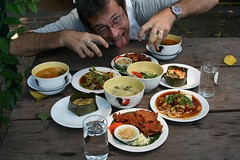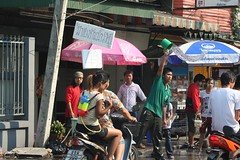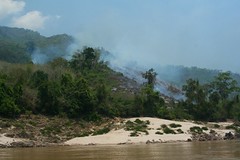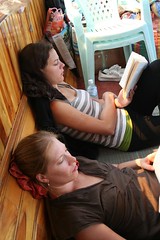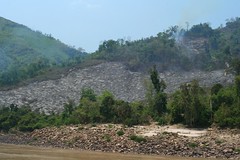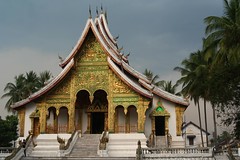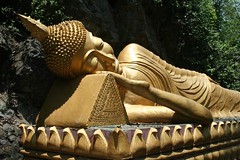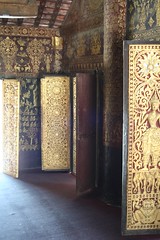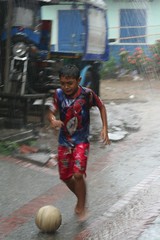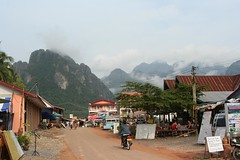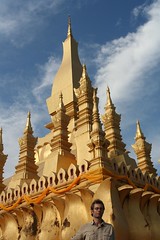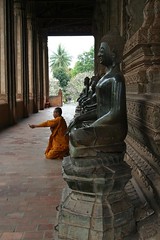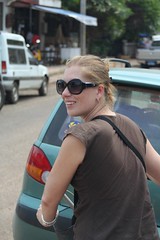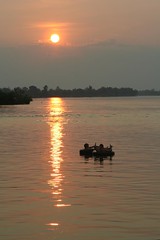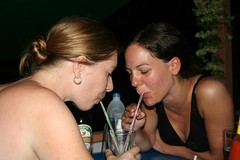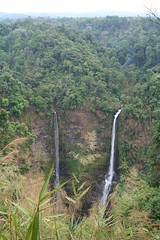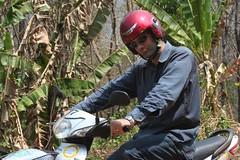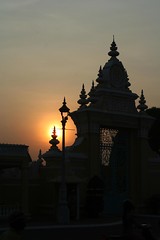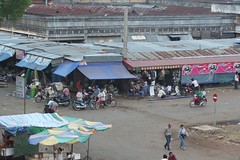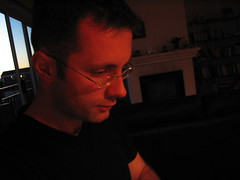Tubing on the Mekong at dusk
Click photo to see slideshow
or here for all Don Det pics
As soon as I got off the boat in Don Det I knew it was the place I’ve been hoping for. I had seen too many crowded cities, busy paved roads, hassling tuk-tuk drivers and growling tour buses. Without even knowing it I had been longing for a hammock under the shade of trees by the riverside. I had been dreaming of a peaceful village with no cars and few people, a haven of silence with dirt paths and bamboo bungalows where the morning crow of the roosters and the music of the roaring waterfalls would be the only disturbing noises. Then our long-tail boat landed on a muddy river bank in Don Det. I was in backpacker heaven.
Our bungalows - Vixay guesthouse
At the southern tip of Laos, the Mekong River spreads into a maze of arms and canals, snaking its way through and around the swarm of islands that dot its waters. Don Det, the most famous outpost in the Four Thousand Islands, is where the crowd of international modern-day hippies goes for a swim, a beer, and countless hours of just watching the waters flow. The islands still live in a time of their own; the local families tend to their riverside guesthouses and patio-restaurants when they are not busy cultivating rice. Electricity is a daily four-hour festival, between 6 and 10 PM. There are no cars, only a few scooters. Nobody runs; everybody seems to be taking a stroll. If you’re looking for the deepest meaning of the words “slow” and “relaxed,” Don Det is the place for you. The French have tried, with little success, to build some infrastructure – a short railroad, a bridge and a few concrete dams – in order to circumvent the furious waterfalls that make the navigation toward the lower Mekong impossible. After their departure, everything fell into ruins.
The tourists, mainly young backpackers and aged hippies, haven’t destroyed the place yet since it’s been “discovered”, about 10 years ago; they’re mostly busy socializing at the small beach on the northern tip of the island, biking their way around, swimming in the natural pools at the
Tat Somphamit waterfalls and getting high on the widely available, cheap ganja. The lack of permanent electrical power contributes in part to keeping the islands isolated and underdeveloped; everyone who loves them would like them to stay so. For as underdeveloped as they are, the islands don’t lack the basic commodities needed by 21st-century backpackers – beer, kept in coolers under blocks of ice, is usually cold enough despite the lack of refrigerators; internet, albeit expensive, is available (running on batteries outside of the electricity window) and in every hamlet lives at least one guy who can fix a flat tire – a skill sorely needed by many
falang who rent bikes to explore Don Det and
Don Khon (its sister island to the south). During our own biking adventure, Angela’s wheels punctured and deflated three times, the same day. Bad luck or bad karma?
Angela and Rahel sipping a Lao-Lao shake
Many people stay on the islands longer than they planned, but “slow” and “relaxed” can become “boring” after a while. We left after three days and took a sawngthaew (a sort of pick-up truck turned bus) to Pakse, the closest bigger town on the Mekong and a former French colonial provincial capital. After peace and quiet we were now missing the creature comforts of modern life: TV, better food and air conditioning. It was time for a bigger adventure: a motorbike tour of the Bolaven plateau. Lonely Planet recommends the plateau, its jungle-covered mountains, the spectacular waterfalls, and the dirt roads winding through sleepy villages as one of the main attractions of southern Laos; we took their word for it and followed the circuit they suggested.
Tad Fan Waterfalls
Click photo to see slideshow
or here for all Bolaven plateau
photos
We left Pakse with our 100cc 4-speed Honda on a rainy morning. As we woke up with the dark skies and warm rain we hesitated for a while; should we just skip the whole plateau-thing and head straight to Vientiane? But we didn’t give up; we left the big backpacks at the Lankham hotel and hopped on the bike with the day bag, a change of clothes, the camera and the computer (which we did not need, but couldn't leave behind). Within minutes my shirt was drenched and we had to stop at the market to buy plastic rain coats. As we arrived frozen and wet at the Tad Fan resort, where we wanted to have lunch at the restaurant overlooking the waterfalls, we were already having second thoughts. What if it was going to rain like that for the next few days? Fortunately it didn’t; the weather got better in the afternoon and by the time we arrived in the Tad Lo village, where we were going to spend the night, the skies had cleared and our clothes had dried.
Kids playing Thai footbal in Tad Lo village
Tad Lo village is a perfect spot to while away a day or two in perfect harmony with nature. There are a few guesthouses with decent restaurants on the banks of the river, a short distance from the waterfalls, and only a handful of quiet backpackers. Unlike in Don Det, where all foreign tourists behave like one big family, there’s none of that overbearing socializing in Tad Lo; you’d almost want to talk in a whisper to your mate at the restaurant so you won’t disturb the divine peace that surrounds the village…
Foreigners come to the villages and towns of the plateau but not in large numbers, and the locals are always forthcoming and eager to practice the few words of English they know. In Attapeu they changed the TV channel to CNN when we sat down in a restaurant; they were happy and surprised when we told them we wanted the Lao traditional noodle-soup for breakfast instead of the omelets and baguettes they expected every falang to eat in the morning.
Driving a bike up and down on the potholed dirt roads of the plateau is no easy affair. Storms broke out a couple of times; we had to stop and take cover under an abandoned house with some Lao boys who were kindling a scrap-wood fire. Another time, as the rain started to pour, a woman invited us in her house; her kids were staring at us the whole time, not sure whether they should laugh or be horrified. And when we thought things were just going great we got into an accident – I tried to avoid two consecutive potholes and the back wheel went skidding out of control. Before we knew it, we were reeling in the dirt, trying to figure out what happened, and the whole village was running toward us to help. Luckily we got away with a few superficial skin wounds, and the bike was fine. We were able continue our drive but we were hurting badly and decided to push all the way back to Pakse to treat our wounds – there was not much in the way of hygiene and medical help in Paksong, a small town in the heart of the plateau, where we had hoped to clean up and spend the night.
Our travel medical kit was more than enough, but out of sheer curiosity and a sense that a professional would do a better job, I decided to go to the local hospital. Surprisingly, it was all very clean and the nurses who treated us did a great job – but then again, they didn’t have to do much; they only cleaned the wounds, rubbed in some iodine and applied sterile plasters. Before long, we were entertaining the whole hospital staff with stories from the trip and bits of information about America. Treatment was free but we had to buy some cheap medical supplies, painkillers and antibiotics. Later that night, we celebrated the return to civilization and our narrow escape from an accident that could have turned much worse, with copious amounts of western food, beer and wine. The next day, we slept.
falang (or farang): generic word used in Thailand, Cambodia and Laos to describe foreigners of European ancestry. A bit like "gringo" in Central and South America.
Posted from Luang Prabang, Laos.
Click here to read more...
Summary only...


